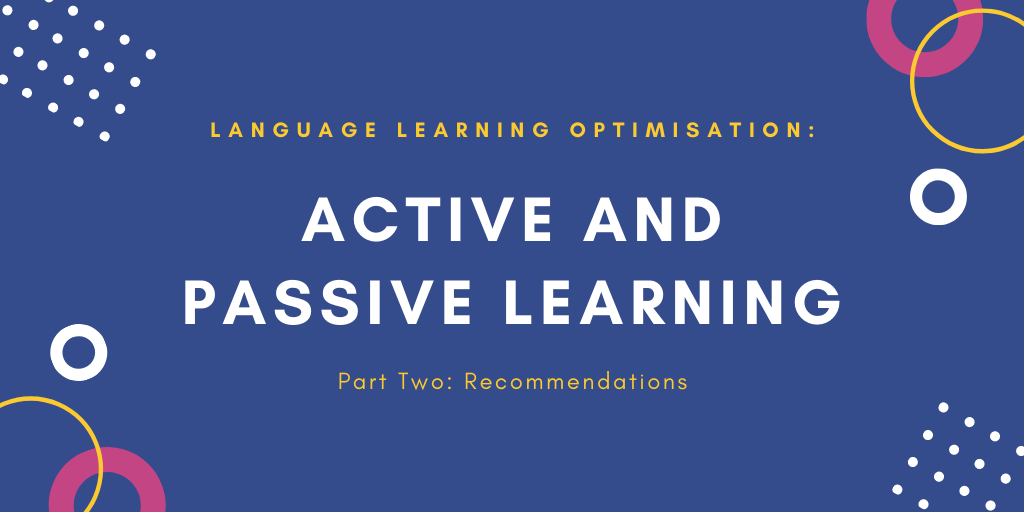In the last post, I introduced you the concept of active and passive learning. Now, let us look at how we can combine these two types of training effectively.
Repetition is the mother of all learning, therefore, the more often you dedicate time to your studies, the greater your progress will be. Three hours once a week do not equal to one hour three times a week. The goal here is to maximise your efficiency not by increasing the amount of time you put into the language training, but by increasing the effectiveness of your daily leaning sessions.
In the last post I already mentioned, that babies are the ultimate active learners, and since on the way to a tongue acquisition we go through the same processes (I talked about that here), we should concentrate on the same actions that kids give most of their attention to. Therefore, if you have only 30 minutes per day for your language studies, you should concentrate all your efforts on the conversational practice.
Speaking lessons address two main constraints we have as adults – equal communication and social sanctioning (we discussed those problems in this post). By choosing a teacher or a study companion, you would create a “safe” environment, where you can work on your speaking skills without the fear of making a mistake. Plus, support and corrections from your partners would artificially simulate the same environment we had as children, where people adapt their vocabulary level and speed of speaking and correct your mistakes.
In case you have some more time to devote to your active practice, try to choose exercises with the high levels of engagement, or immersion-like approach, since the more effort you put into recalling a piece of information or executing a skill, the more this act benefits the learning. Good examples of such training are:
- Writing short texts and essays in a target language (and submitting them later to your teacher or partner for correction).
- Creating your vocabulary cards instead of always using the pre-made ones (engagement with the process of creation will allow you to recall words faster later).
- Actively listening to podcasts and native conversations (In the process, try to jot down the unknown words or repeat new expressions and constructions).
To most effectively complement our active studies with a passive approach, we need to remember, that main purpose of the passive learning is to increase your familiarity with the tongue, help you to recognise constructions and contexts faster. For these exercises to be effective without being too boring or tiring, it is important to choose ones that adequately match your current language level.
For example, if you are a beginner, news’ podcasts won’t bring you much due to their difficulty, while for the advanced students, news and conversational podcasts are more beneficial than the “intermediate grammar” ones.
Try to choose podcasts recorded in the native speech only. When it is not possible, choose ones where grammar constructions and words complemented with the minimum amount of explanations, rather than the ones where 1 minute of native dialogue mixed with 25 minutes of regular chit chat.
Watching films with subtitles is also a great opportunity to increase your familiarity with the native speech. An Important rule to follow while watching videos is to watch films in a language they were filmed in. Why? When we communicate, we don’t only listen to the words, but also follow lips’ movements and watch others’ body language. Therefore, if the film was filmed in English, watching the Spanish dubbed version will only confuse your brain, since the audio won’t match the people oral articulations.
You can also switch your phone’s settings, play computer and video games in another tongue or stick post-its with translations onto the daily items in your home. The important point here is to integrate such activities slowly and find processes that fit your life without complicating it. If the brain starts perceiving something as complication or difficulty instead of pleasure it will subconsciously try to avoid it.
In general, inviting the new language to your life by using every opportunity to get exposed to it will decrease your levels of stress during future real-life encounters. The more the new tongue becomes the part of your daily life, the more your brain will consider it to be something useful and worth caring about.
In the next post, I will tell you more about my favourite platform – iTalki – and explain how I choose teachers for my conversational practice.
Now, could you tell me which types of active and passive training do you like the most? What works best for you? Please, let me know in the comments below.
For my Russian readers: the content of this article is also available on Russian as an IGTV video here: https://www.instagram.com/p/CBGTlFADEF_/




I prefer films with subtitles and language tandem when a very patient person. It helps.
Living in the country of the language
Hi Sabine! Was interested to read!
I like to watch movies, and also to do language lessons on Skype!
I like to use Podcasts while learning English. My favorite one is „6 Minute English“. I used to listen to it every day and I see the result. I advise it to everyone!
Hi, Sabina! Thank you for your advice. I have active lessons twice a week and also I watch movies with English subtitles and read books. I like that you mentioned an aspect of enjoyment. It really works better when you are interested in material which you’re watching or reading. In that reason, listening your favorite songs is the best passive training. You can remember whole phrases and sentences easily.
Thank you!! It is really interesting!
I watch movies with subtitles, i read a book , where i already translated all unknown words, and wrote it on the side of the page, it is very convenient:)
Dear Sabina. Thank you. It is very interesting.
Dear Sabina, thank you for advice. We are watchng films with subtitles . It helps to learn language.
Thank you for the new interesting article. I wish you good luck in your future scientific discovery!
I prefer to watch the movies with subtitles.
I really like watching films with subtitles, thin k it is a great way to learn the language!
I like the option of watching movies with subtitles)